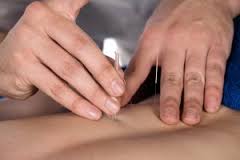What is Dry Needling?
 “Dry Needling is a skilled intervention performed by a physical therapist that uses a thin filiform needle to penetrate the skin and stimulate underlying myofascial trigger points, muscular and connective tissues for the management of neuromusculoskeletal pain and movement impairments.” (American Physical Therapy Association Dry Needling Task Force, May 2012) Physical Therapists use dry needling to decrease pain, increase range of motion, and to restore function. Karl Lewit, MD, DSC. published “The Needle Effect”, in 1979 stating that a needle could be used as an extension of treatment of orthopedic dysfunctions. The original treatment used a hypodermic needle and an injectable substance for pain relief, until it was discovered that a dry needle could achieve the same result. Since then, the hypodermic needle has been replaced with a solid filament needle and is what we refer to today as dry needling.
“Dry Needling is a skilled intervention performed by a physical therapist that uses a thin filiform needle to penetrate the skin and stimulate underlying myofascial trigger points, muscular and connective tissues for the management of neuromusculoskeletal pain and movement impairments.” (American Physical Therapy Association Dry Needling Task Force, May 2012) Physical Therapists use dry needling to decrease pain, increase range of motion, and to restore function. Karl Lewit, MD, DSC. published “The Needle Effect”, in 1979 stating that a needle could be used as an extension of treatment of orthopedic dysfunctions. The original treatment used a hypodermic needle and an injectable substance for pain relief, until it was discovered that a dry needle could achieve the same result. Since then, the hypodermic needle has been replaced with a solid filament needle and is what we refer to today as dry needling.
So how does dry needling work? Research has shown that trigger points contain increased inflammatory chemicals, increased contraction of muscle fibers, and decreased blood flow. These trigger points can cause a number of symptoms such as; pain upon palpation or referred pain (pain in another area of the body). A small filiform needle is used to deactivate hyper irritable spots (trigger points) within the muscle. Insertion of the needle into these points causes a local twitch response, which increases blood flow and decreases binding. Dry needling is always followed with a manual therapy technique or corrective exercise. It is a great tool that has helped many of my patients return to pain free activity.
My experience with dry needling at our clinic is that is has helped my patients suffering with many different types of pain. A great example of a dry needling success story is a patient that came to me after suffering with a severe headache for three months following a car accident. After assessing the patient, I was able to determine that his upper trap was the significant pain generator causing his headache. After one session of dry needling, the patient reported that his headache was gone.
Dry needling is one tool I use to make changes within a treatment session. Positive changes include decreased pain, increased range of motion, or improved movement patterns. Call us today to see how dry needling can help you.
